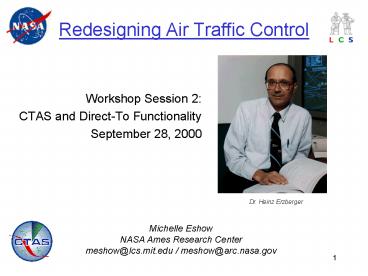Redesigning Air Traffic Control - PowerPoint PPT Presentation
1 / 18
Title:
Redesigning Air Traffic Control
Description:
first 2 tools (TMA, pFAST) field tested at DFW in 1997; now being deployed by ... operates Direct-To primarily with mouse. Keyboard for backup and engineering ... – PowerPoint PPT presentation
Number of Views:83
Avg rating:3.0/5.0
Title: Redesigning Air Traffic Control
1
Redesigning Air Traffic Control
- Workshop Session 2
- CTAS and Direct-To Functionality
- September 28, 2000
Dr. Heinz Erzberger
Michelle Eshow NASA Ames Research
Center meshow_at_lcs.mit.edu / meshow_at_arc.nasa.gov
2
CTAS Background
- CTAS Center-TRACON Automation System
- a suite of decision support tools for ATC
- concept started at NASA in late 80s supported
by FAA since 1991 - first 2 tools (TMA, pFAST) field tested at DFW in
1997 now being deployed by FAA and its
contractors under FAA Free Flight Phase 1
program - Running at Minn., Denver coming to LAX, ATL,
STL, MIA, SFO - FAA/NASA continue to run NASA software version at
DFW/ZFW to refine current tools, develop future
products - CTAS represents a rare success in development and
tech transfer of usable, effective automation for
ATC
3
CTAS Tools
- Traffic Management Advisor (TMA)
- schedules aircraft arriving at major airports
(from Center into TRACON) - provides flow viz aids to TMCs at Center and
TRACON - provides STA and current delay to Center sector
controllers - Passive Final Approach Spacing Tool (pFAST)
- determines optimum runway for each arriving
aircraft - determines landing sequence for all aircraft on a
runway - provides runway and sequence to TRACON
controllers - Collaborative Arrival Planner (CAP)
- securely provides CTAS data to airlines for use
in near-term planning
4
CTAS Tools
- Direct-To (D2)
- looks for time-saving shortcuts in aircraft
flight plan routes - Active FAST (aFAST)
- adds graphical turn and speed advisories to pFAST
to help controllers achieve runway assignment and
sequencing - Multi-Center TMA (McTMA)
- extends TMA to handle the Northeast corridor in
which PHL TRACON borders NY and Washington
Centers and arrival planning must start in
Cleveland Center - plus others of less significance or not in
active development
5
CTAS Design Philosophy
- Automation should
- serve the human (controller, pilot, dispatcher,)
and not vice versa - enhance controllers perception of traffic
situation - complement controller skills
- achieve well defined objectives
- be designed with controllers as members of design
team - be refined and validated in field tests
6
Technical Approach
Operational
Test
Preparation
for Operational
Development Progress
Test
Adaptation
Controller and Pilot involvement
Assessment Team
for Target
Site
System
Development
Initial
Team (SDT)
Software
Human Factors
Concept
On-site Controllers
Participating Airlines
Analysis
Definition
Shadowing
Engineers Computer Scientists Human Factors
Experts Local Controllers, Pilots Dispatchers
Real-time Simulation
Fast-time Simulation
7
Internal Development Process
Research Groups (AFA, AFC)
Specification of Algorithms Computer-human
interface External interface Data collection Etc.
Passive testing with live data
Functional requirements development
Controller-in-loop simulation
Field testing
Daily use
Testing
Software Design, Development
Validation Verification
Development Group (AFD)
Release
8
Advantages of Approach
- Detailed requirements and design evolve from
knowledge of actual operations - Forces a human-centered automation design
philosophy - Assures air traffic controller and airline
involvement throughout design process - Forces concurrent design of computer human
interface and training program - Leads to early products
9
CTAS at DFW/ZFW
FAST at DFW TRACON
TMA at Fort Worth Center
10
Direct-To Origins
- Potential of a Direct-To Tool was discovered
unexpectedly during field tests of CTAS Conflict
Probe / Trial Planning functions at Denver Center
(Sept. 97) and was confirmed at Fort Worth Center
(Nov. 98) - At both Centers, controllers pointed out a
preferred use for the Trial Planning function
searching for and evaluating direct routes that
are conflict free - The Direct-To Tool was built to automate search
for and execution of direct route trajectories
11
Direct-To Tool
- Direct-To identifies aircraft that can save at
least one minute by flying direct to a
down-stream fix on their route of flight. - Direct-To list on controllers display shows
eligible aircraft, time savings, direct-to fixes,
and conflict status.
- Point-and-click Trial Planner allows controllers
to easily display, modify, and send Direct-To
flight plan amendments into the Host computer. - Potential savings in flying time for Ft. Worth
Center airspace is approximately 1,800 minutes
per day or about 2.5 minutes per Direct-To
clearance advisory.
12
Trial-Planning a Direct-To Advisory
13
Direct-To Functions
- Predict 4-Dimensional trajectories for all
tracked aircraft every track update (12 seconds) - uses wind and aircraft performance data
- Probe all trajectories for conflicts and display
results - Probe all non-arrival trajectories to search for
time-saving shortcuts, and display results - Trial Planner
- modify aircraft clearances without affecting
other controller displays changes can be
rejected easily mouse-driven - to speed response to controller inputs, trial
plan trajectories are re-computed and re-analyzed
every second - if controller accepts new flight plan, it can be
sent back to Host as an amendment
14
Additional Functions
- Can generate arrival trajectories to meet the TMA
STA, and extract controller advisories to achieve
that trajectory - Can predict loading of sectors (aka dynamic
density) - Spacing Tool to assist miles-in-trail en-route
metering - Numerous data collection options
15
Direct-To Field Test (10/2000)
- Direct-To runs on auxiliary flat panel displays
at 3 ZFW sector positions - Controller operates Direct-To primarily with
mouse. - Keyboard for backup and engineering set up
- Articulated arm facilitates configuration changes
for experiment phases and non test periods - NASA observer answers questions, takes notes
16
Direct-To Test Setup
17
Test Installation
18
Direct-To Plans
- Validate concept in field test next month
- Continue to refine software and add features (eg,
routing around special use airspace) - Continue tech transfer to FAA
- Award contract to re-implement display on R and
D side of sector workstations - Redesign core algorithmic component
(profile_selector_cntr) to achieve more reliable
and maintainable software































